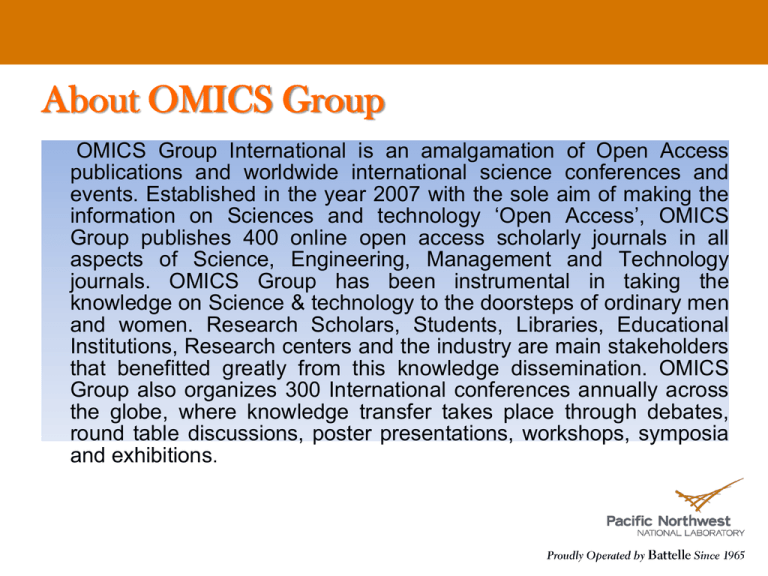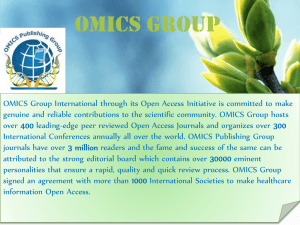Transformational Materials Science Initiative Review
advertisement

About OMICS Group OMICS Group International is an amalgamation of Open Access publications and worldwide international science conferences and events. Established in the year 2007 with the sole aim of making the information on Sciences and technology ‘Open Access’, OMICS Group publishes 400 online open access scholarly journals in all aspects of Science, Engineering, Management and Technology journals. OMICS Group has been instrumental in taking the knowledge on Science & technology to the doorsteps of ordinary men and women. Research Scholars, Students, Libraries, Educational Institutions, Research centers and the industry are main stakeholders that benefitted greatly from this knowledge dissemination. OMICS Group also organizes 300 International conferences annually across the globe, where knowledge transfer takes place through debates, round table discussions, poster presentations, workshops, symposia and exhibitions. About OMICS Group Conferences OMICS Group International is a pioneer and leading science event organizer, which publishes around 400 open access journals and conducts over 300 Medical, Clinical, Engineering, Life Sciences, Phrama scientific conferences all over the globe annually with the support of more than 1000 scientific associations and 30,000 editorial board members and 3.5 million followers to its credit. OMICS Group has organized 500 conferences, workshops and national symposiums across the major cities including San Francisco, Las Vegas, San Antonio, Omaha, Orlando, Raleigh, Santa Clara, Chicago, Philadelphia, Baltimore, United Kingdom, Valencia, Dubai, Beijing, Hyderabad, Bengaluru and Mumbai. Design and Applications of Redox Active Materials for Advanced Redox Flow Batteries Tianbiao Leo Liu (Tianbiao.Liu@pnl.gov) Wei, Xiaoliang; Xu, Wu; Cosimbescu, Lelia; Vijayakumar, Murugesan; Nie, Zimin; Liu, Jun; Wang, Wei; Sprenkle, Vincent Pacific Northwest National Laboratory 902 Battelle Boulevard P. O. Box 999 Richland, WA 99352, USA 3 Redox flow batteries (RFB) Flow Cell Advantages: Separation of energy and power Active heat management Safety Large scale energy storage (MWs/MWhs) Potential low cost Manufacture easiness (modular) 4 Static Cell (e.g Li ion) Zhenguo Yang, et. al. Chemical Reviews, 111, 2011, 3577 Wei Wang, et. al. AFM, 2012, State-of-art aqueous RFB Fe/V RFB Mixed-acid VRB Double Energy Density Extend temperature window Higher utilization, stable cycling Low-cost membrane 2.5M, ~30Wh/L, -5~60oC 1.5M, ~15Wh/L, -5~60oC • Licensed to Unienergy Co. and other three Cl + 2H ε =1.0 V •V + e2013 VO FLC Award V ε =-0.25 Catholyte: VO2+ + Cl- + H2O – e Anolyte: Overall: 5 3+ VO2+ + Cl- + H2O + V3+ Charge Discharge Charge Discharge Charge Discharge 2 + co 2+ ao VO2Cl + 2H+ + V2+ Eo=1.25 V W. Wang, et al, EES, 4, 4068, 2011 L. Li, et al. AEM, 1, 394, 2011 Limitation of Aqueous RFB Shinkle, et al. JPS, 2012, 206, 490 Limitation of aqueous RFB Low voltage (H2/O2 gas evolution) Expensive, > $500 kWh Low energy 6 Advantages of Nonaqueous RFB High voltage Potential high energy/power density Free from gas evolution Lower costs Background of Ferrocene (Fc) Versatile ferrocene A foundation complex for the field of Organometallic Chemistry FeII (also a Noble prize compound for Wilkinson and Fisher in 1973) Fc and its derivatives widely used in synthesis, catalysis, medicine, electrochemistry and material chemistry Cathode materials for rechargeable Li ion batteries Pristine Fc has poor solubility (ca. 0.2 M) in polar EC/PC/EMC and not good for NARFB (Li metal based semi-flow batteries). 7 Functionalized Fc as Catholyte F 3C Br Fe N Br acetonitrile, rt Fe N LiTFSI Fe O O S N S CF3 O O 1.73 (EC/PC/EMC 4:5:1) N Fc1N112-TFSI H 2O, rt PF6 NaPF 6 acetonitrile Fe N NaClO 4 acetone/acetonitrile Fe N Fe methanol/acetonitrile N 0.63 M Fc1N112-ClO 4 BF4 NaBF 4 1.71 M Fc1N112-PF 6 ClO4 8 M (79.5 Wh/L) 0.40 M (30 Wh/L) Fc1N112-BF 4 Understanding of Solvation Chemistry – DFT DFT calculation suggests the tetraalkylammonium cation improves the interactions with solvent molecules O O O O positive O O O O O O O O O O O O O O negative 9 Static Cells of Functionalized Fc as Cathode Model tests: Fc (cathode) / Li (anode) static cell configuration • High columbic efficiency (CE), voltaic efficiency (VE) and energy efficiency (EE), > 90% • Good capacity retention due to SEI mitigated self-discharge • Good candidates for RFB applications (FcTFSI-Li, 76 Wh/L) 10 Flow Cell Cycling at High-Concentration Fc-TFSI 11 • Not successful with a Li metal anode even at 0.2M FcTFSI with 15wt% FEC • The reason is the excessive Li dendrite with more redox species present. Hybrid Anode Assembly Li metal graphite felt J. Liu et al Nat Commun. 2014,5,3015 • Change Li deposition/stripping chemistry to Li+ ion intercalation decreased involving of Li metal deposition 12 • Anode side is a shortened cell not sacrificing cell potential Hybrid Anode Enables High Concentration Cycling 0.8M Fc-TFSI / 1.2M LiTFSI / EC-PC-EMC / 15wt% FEC 2.8 – 4.0 V, 1.5 mA/cm2 13 • CE: 85 – 91%, VE: 87 – 83%, EE: ~76% • Energy density delivery ~ 50 Wh L-1 • Moderate capacity retention Conclusions We have successfully demonstrated a hybrid Lithiumorganic redox flow battery using ferrocene as the catholyte redox material. Structural modification increases the ferrocene solubility by 20 times. Li metal anode works at low Fc-TFSI concentration, while a hybrid anode enables decent cycling at high Fc-TFSI concentrations up to 0.8M. Flow cell tests produce stable cyclability with EE >75% and energy density of 50 Wh L-1. Key challenge is long-term anode protection. 14 Acknowledgements Financial Support from financial support from the U.S. DOE’s Office of Electricity Delivery & Energy Reliability (OE, Dr. Imre Gyuk). Colleagues: Lelia Cosimbescu, Vincent Sprenkle, Wei Wang, Wu Xu, Jun Liu, M. Vijayakumar, Bin Li. Professor C. Austen Angell (Arizona State University) for helpful discussions and comments. 15 Thanks for your attention! 16 Functionalized Fc as Catholyte 1H NMR 13C NMR 3.25 V 17 3.5 V Understanding of Solvation Chemistry – NMR Co-axial NMR to investigate the cation – solvent interactions Sample NMR ref TMS 18 No chemical shift change at low concentrations of either pristine ferrocene or Fc-TFSI Understanding of Solvation Chemistry – NMR NMR shift 19 Spacing between solvent peaks remain constant no cation-solvent chemical binding Parallel upfield shift for both solvents and Fc-TFSI enhanced solvation interactions Compared to solvent peaks, protons on unsubstituted ring remain unchanged while protons on substituted rings change significantly solvation primarily on the cation Presence of the quaternary ammonium increases the solubility Hybrid Anode Enables High Concentration Cycling 0.5M Fc-TFSI / 1.0M LiTFSI / EC-PC-EMC / 15wt% FEC 2.8 – 4.0 V, 2.5 mA/cm2 20 • CE: 92%, VE: 87%, EE: 80% • Energy density delivery ~ 38 Wh L-1 • Remarkable capacity retention over 20 cycles Let Us Meet Again We welcome you all to our future conferences of OMICS Group International Please Visit: http://materialsscience.conferenceseries.com/ Contact us at materialsscience.conference@omicsgroup.us materialsscience@omicsgroup.com






